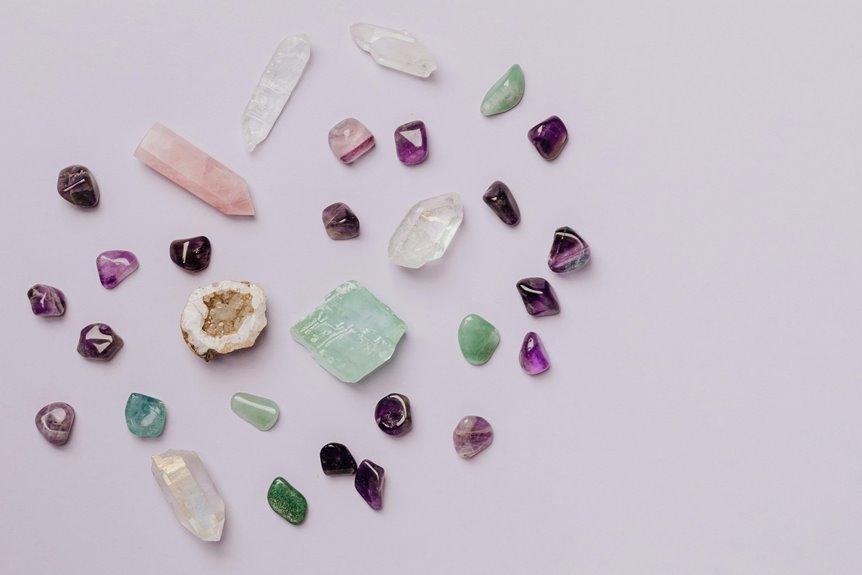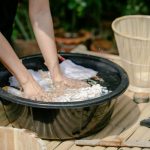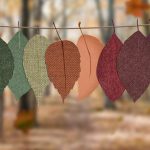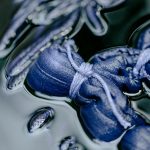To create rock-like geode tie-dye patterns, start by folding your cotton fabric accordion-style and securing it with rubber bands to mimic crystal rings. Use fiber-reactive dyes in layered, complementary colors applied with squeeze bottles to build depth and natural-looking veins. Keep the fabric damp for better dye flow and wear gloves to protect your hands. Mastering these basics will help you replicate stunning geode patterns, and you can explore more techniques to perfect your design.
Table of Contents
Key Takeaways
- Fold fabric accordion-style and pinch the center to mimic natural geode shapes before securing with rubber bands for defined rings.
- Use fiber-reactive dyes in complementary colors and apply them in concentric layers to create depth and mineral-like veins.
- Apply dye with squeeze bottles for precise control, blending colors while preserving some areas for natural contrasts.
- Keep fabric damp with a spray bottle to control dye spread and enhance the geode texture.
- Wear protective gloves and work on a covered surface in a well-ventilated area to prevent staining and ensure safety.
Understanding the Geode Tie-Dye Technique
Although the geode tie-dye technique might seem complex at first, you can easily master it by understanding its core principles. This method mimics the natural patterns found in geodes—those beautiful, crystalline rock formations.
You’ll create concentric circles and irregular lines that resemble mineral veins. The key is controlling how the dye spreads on fabric folded or scrunched to replicate the layered look of geodes. You apply multiple colors strategically to build depth, blending shades while keeping some areas defined.
Essential Materials and Tools Needed
To create stunning geode tie-dye patterns, you’ll need some basic dyeing supplies like fabric dye, squeeze bottles, and rubber bands.
Don’t forget to protect yourself with gloves and an apron to keep the dye off your skin and clothes.
Having the right materials and protective gear makes the process safer and more enjoyable.
Basic Dyeing Supplies
Creating stunning geode tie-dye patterns starts with gathering the right supplies.
You’ll need fiber-reactive dyes in vibrant colors to mimic natural geode hues. Grab squeeze bottles for precise dye application, ensuring you can control where colors blend. A plain white cotton shirt or fabric works best since it absorbs dye well.
Don’t forget rubber bands to section your fabric and create those signature geode rings. Have a spray bottle filled with water handy to keep the fabric damp, which helps colors spread smoothly.
Also, prepare a plastic table cover or tray to protect your workspace. Finally, keep some paper towels nearby for quick cleanup.
With these basic supplies ready, you’re set to plunge into the exciting process of geode tie-dyeing.
Protective Gear Options
Once you’ve gathered your dyeing supplies, it’s important to protect yourself throughout the process. You’ll want to wear rubber gloves to keep your hands safe from harsh chemicals and prevent staining.
An apron or old clothing is a must to shield your clothes from accidental splashes. Consider using safety goggles if you’re working with powdered dyes to avoid irritation from airborne particles.
Working in a well-ventilated area or wearing a mask helps protect your lungs from fumes. Also, cover your work surface with plastic or newspaper to prevent stains and make cleanup easier.
Preparing Your Fabric for Dyeing
Before you plunge into dyeing your fabric, you’ll want to make certain it’s properly prepared to absorb the colors evenly. Start by washing your fabric without fabric softener to remove any sizing or oils that might block the dye. Next, dampen the fabric slightly; a moist base helps the dye spread better and creates those natural geode patterns.
Here’s a quick prep checklist:
| Step | Action | Tip |
|---|---|---|
| Wash | Use mild detergent | Avoid fabric softener |
| Rinse | Rinse thoroughly | Removes detergent residue |
| Dampening | Lightly spray or soak fabric | Keeps dye spreading evenly |
| Wrapping/Tying | Fold and bind as desired | Creates pattern definition |
Proper prep makes certain your geode tie-dye turns out vibrant and striking every time!
Mixing Colors to Mimic Natural Geodes
You’ll want to pick complementary colors that naturally appear in geodes to create a believable look.
Layering these hues carefully adds depth and dimension to your design.
Let’s explore how to combine shades and apply them for the best effect.
Choosing Complementary Color Palettes
When selecting color palettes for geode tie-dyeing, understanding how hues interact helps you recreate the natural beauty of geodes. You want to pick colors that not only contrast but also harmonize, giving your design depth and vibrancy. Complementary colors—those opposite each other on the color wheel—make your patterns pop, mimicking the striking contrasts seen in real geodes.
Here’s a quick guide to complementary palettes that work well for geode patterns:
| Primary Color | Complementary Color |
|---|---|
| Purple | Yellow |
| Blue | Orange |
| Green | Red |
| Teal | Coral |
| Navy | Gold |
Mix these thoughtfully, and your tie-dye will capture the lively essence of natural geodes.
Layering Techniques for Depth
Although selecting vibrant colors is essential, mastering layering techniques brings your geode tie-dye patterns to life by adding depth and dimension.
Start by applying lighter colors as your base, then gradually layer darker shades to mimic the natural mineral bands found in geodes. Use careful folds and scrunches to control where each color lands, creating subtle changes.
Don’t hesitate to overlap colors slightly; this blending simulates the way minerals merge in real stones. You can also experiment with spraying or dabbing dye between layers for texture variation.
Remember, patience is key—allow each layer to set partially before adding the next to prevent muddiness.
With these layering techniques, your tie-dye will capture the intricate, multi-dimensional beauty of natural geodes perfectly.
Step-by-Step Guide to Folding and Tying
Before diving into the dyeing process, mastering the folding and tying techniques is essential to create those stunning geode patterns.
Start by laying your fabric flat, then fold it accordion-style to compress the area where you want the geode effect. Pinch the center tightly to mimic the natural shape of a geode.
Next, use rubber bands to secure the folds firmly; these act as barriers that keep dye from penetrating certain areas, forming the crystal-like outlines. For added texture, twist or scrunch parts of the fabric before tying.
Applying Dye for Layered Effects
Now that you’ve mastered folding and tying, it’s time to bring your geode patterns to life by applying dye in layers.
Start with lighter colors first, as they’ll serve as the base and give your design depth. Apply these gently around the tied areas, letting the dye soak in unevenly to mimic natural stone textures.
Next, add darker hues strategically, focusing on the “cracks” and edges you created with your folds. Use a brush or squeeze bottle for precision, layering colors to build contrast and dimension.
Remember to leave some white spaces untouched to replicate the mineral highlights in geodes. Take your time with each layer, allowing slight drying between applications to prevent colors from blending too much.
This layered approach creates vibrant, rock-like patterns with authentic complexity.
Setting the Dye and Finishing Touches
Once you’ve layered your dyes to capture the geode’s natural beauty, it’s crucial to set the colors properly to guarantee they stay vibrant and long-lasting.
Start by wrapping your fabric in plastic to keep it moist, then let it sit for 6 to 8 hours or overnight. This waiting period allows the dye to fully bond with the fibers.
Afterward, rinse your piece under cold water to remove excess dye, gradually switching to warm water until it runs clear.
Finally, wash your fabric separately with a mild detergent and air dry or tumble dry on low heat.
For extra flair, consider adding metallic fabric paint or subtle glitter along the edges to mimic the sparkle of real geodes. These finishing touches complete your unique, eye-catching design.
Frequently Asked Questions
Can Geode Tie-Dye Be Done on Synthetic Fabrics?
Wondering if synthetic fabrics can handle geode tie-dye? They usually don’t absorb dye well, so you might struggle with vibrant patterns. You’ll want natural fibers like cotton to get those stunning rock-like effects.
How Do You Wash Geode Tie-Dye Garments to Preserve Colors?
You should wash your garment in cold water with mild detergent, using a gentle cycle or hand washing. Avoid bleach and harsh chemicals, then air dry to preserve the vibrant colors and prevent fading over time.
Are There Eco-Friendly Dyes Suitable for Geode Tie-Dye?
You can use eco-friendly dyes like plant-based or fiber-reactive dyes that are low-impact and non-toxic. They’re great for vibrant colors and work well with natural fibers, helping you keep your process sustainable and safe.
Can This Technique Be Applied to Non-Fabric Items?
Imagine painting the Aurora Borealis on wood or ceramics; you can definitely apply this technique beyond fabric. Just pick porous surfaces, prep them well, and let your creativity flow—watch stunning, rock-like patterns come alive anywhere.
What Are Common Mistakes to Avoid in Geode Tie-Dyeing?
You shouldn’t rush the dyeing process or use too much water, as it can blur patterns. Avoid uneven folding and over-saturating colors. Also, don’t skip setting the dye properly to keep those crisp, vibrant designs.
- Geode Tie-Dyeing: How to Create Rock-Like Patterns - July 13, 2025
- The Spider and Black Hole Tie-Dye Techniques Explained - July 13, 2025
- How to Make a Tie-Dye Heart Shape Step-by-Step - July 13, 2025







